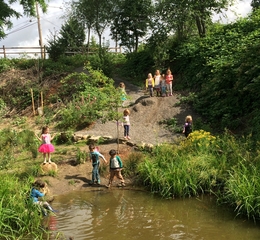During plant week we learned about different types of plants. We went on a long nature walk and identified all of the different kinds of plants we could see, including flowers, trees, bushes, vegetables, grass, etc. Then we brought a plant into the classroom and learned about the different parts…


We then focused on flowers, and learned about the different parts of a flower- some children made books and labeled the different parts of a flower!

One day we did a special activity where we planted cilantro seeds in the top of a mason jar so we could watch the roots grow down to the water, and then harvest and feed rainbow dash after the cilantro grows tall enough!


We read a book that talked about all the different things that we eat and how they are different parts of a plant! For example, when we eat asparagus we are eating the flower, when we eat carrots we are eating the roots, and when we eat spinach we are eating the leaves!

And then we harvested and ate some veggies from our garden!

Some activities on the shelves that the children got to do throughout the week were planting a seed- where they got to create a pot out of newspaper, fill it with dirt and then plant a seed inside!




And plant collage- where they got to gather shapes and create flowers and other plants out of them!

On Friday we had a special guest. Ellen’s mom Bethany came in and taught us about different plants on our property!!
She told us the name of the plant with the blue flowers on our property, Chickory! She also shared that before people knew how to make coffee they would take roots from the Chickory plant and grind it up to make tea as a way to wake up. The children thought that we should gather some Chickory and use our coffee grinder and french press to make our own Chickory tea!

We also learned about Queen Annes Lace, otherwise know was Wild Carrot! We noticed the similarity between carrot roots and the roots of Queen Annes Lace.

Bethany taught us about the two different kinds of roots; fibrous roots that reach out side to side and tap roots that grow really far down so they can drink more water. We pulled up a Queen Annes Lace, noted the similarity between it and a carrot…

And discovered that it is a tap root!
Lastly we learned about Yellow Dock. We learned that when the seeds turn brown that means that they are ready to be spread around by pollinators like wind, bees and humans. We pretended to be bees and grabbed a handful of seeds and spread them around so that maybe next year there will be more Yellow Dock growing on our property!


Stay tuned next week for our last week of nature camp, all about birds!





